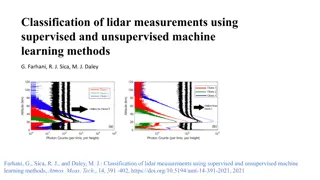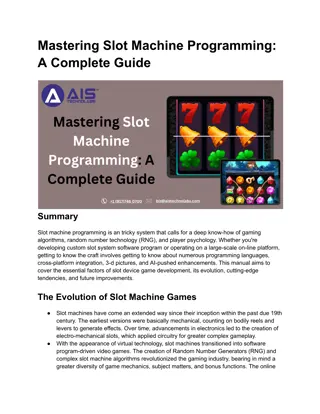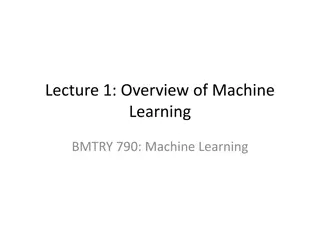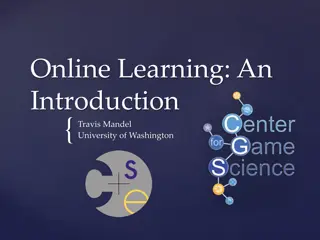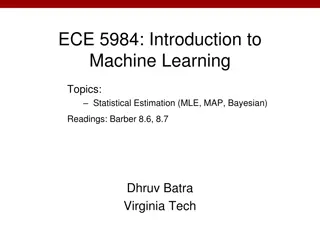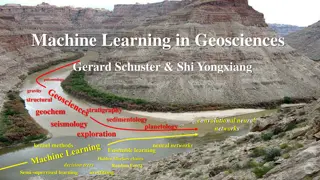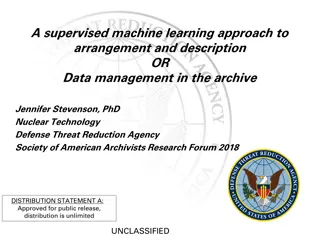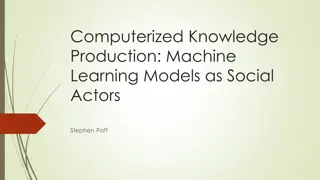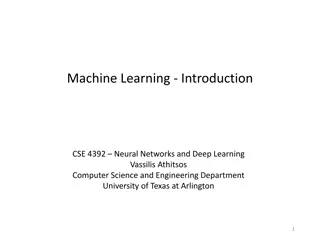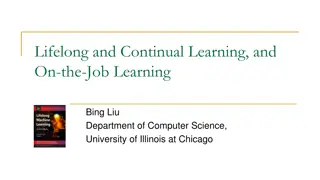Introduction to Machine Learning Concepts
This text delves into various aspects of supervised learning in machine learning, covering topics such as building predictive models for email classification, spam detection, multi-class classification, regression, and more. It explains notation and conventions used in machine learning, emphasizing vectors, matrices, and scalar values. The content highlights the essential concepts and applications of supervised learning models in a straightforward manner.
Download Presentation

Please find below an Image/Link to download the presentation.
The content on the website is provided AS IS for your information and personal use only. It may not be sold, licensed, or shared on other websites without obtaining consent from the author. Download presentation by click this link. If you encounter any issues during the download, it is possible that the publisher has removed the file from their server.
E N D
Presentation Transcript
Learning with Prototypes CS771: Introduction to Machine Learning Nisheeth
2 Supervised Learning Labeled Training Data dog Supervised Learning Algorithm dog cat Cat vs Dog Prediction model cat cat Predicted Label (cat/dog) A test image Cat vs Dog Prediction model CS771: Intro to ML
3 Some Types of Supervised Learning Problems Consider building an ML module for an e-mail client Some tasks that we may want this module to perform Predicting whether an email of spam or normal: Binary Classification Predicting which of the many folders the email should be sent to: Multi-class Classification Predicting all the relevant tags for an email: Tagging or Multi-label Classification Predicting what s the spam-score of an email: Regression Predicting which email(s) should be shown at the top: Ranking Predicting which emails are work/study-related emails: One-class Classification These predictive modeling tasks can be formulated as supervised learning problems Today: A very simple supervised learning model for binary/multi-class classification This model doesn t require any fancy maths just computing means and distances CS771: Intro to ML
4 Some Notation and Conventions In ML, inputs are usually represented by vectors A vector consists of an array of scalar values Geometrically, a vector is just a point in a vector space, e.g., A length 2 vector is a point in 2-dim vector space A length 3 vector is a point in 3-dim vector space 0.5 0.5 0.3 0.3 0.6 0.6 0.1 0.1 0.2 0.2 0.5 0.5 0.9 0.9 0.2 0.2 0.1 0.1 0.5 0.5 Likewise for higher dimensions, even though harder to visualize (0.5,0.3) (0.5,0.3,0.6) 0.5 0.5 0.3 0.3 0.6 0.6 0.5 0.5 0.3 0.3 Unless specified otherwise Small letters in bold font will denote vectors, e.g., ?, ?, ?etc. Small letters in normal font to denote scalars, e.g. ?,?,?, etc Capital letters in bold font will denote matrices (2-dim arrays), e.g., ?,?,?, etc CS771: Intro to ML
5 Some Notation and Conventions A single vector will be assumed to be of the form ? = ?1,?2, ,?? Unless specified otherwise, vectors will be assumed to be column vectors So we will assume ? = ?1,?2, ,?? to be a column vector of size ? 1 Assuming each element to be real-valued scalar, ? ? 1 or ? ? ( : space of reals) If ? = ?1,?2, ,?? is a feature vector representing, say an image, then ? denotes the dimensionality of this feature vector (number of features) ??(a scalar) denotes the value of ?? feature in the image For denoting multiple vectors, we will use a subscript with each vector, e.g., N images denoted by N feature vectors ?1,?2, ,?N, or compactly as ?? ?=1 The vector ?? denotes the ?? image ??? (a scalar) denotes the ?? feature (? = 1,2, ,?) of the ?? image ? CS771: Intro to ML
6 Some Basic Operations on Vectors Addition/subtraction of two vectors gives another vector of the same size ? The mean ?(average or centroid) of ? vectors ?? ?=1 ? 1 ? ?=1 ? = ?? (of the same size as each ??) The inner/dot product of two vectors ? ?and ? ? Assuming both ? and ? have unit Euclidean norm (a real-valued number denoting how similar ? and ? are) ? ?,? = ? ? = ?=1 ???? For a vector ? ?, its Euclidean norm is defined via its inner product with itself ? 2 ?2= ? ? = ?=1 ?? CS771: Intro to ML
7 Computing Distances Euclidean (L2 norm) distance between two vectors ? ?and ? ? Another expression in terms of inner products of individual vectors Sqrt of Inner product of the difference vector ? 2= ? ? ? ? = ? ? + ? ? 2? ? ?2?,? = | ? ? |2= ?? ?? ?=1 Weighted Euclidean distance between two vectors ? ?and ? ? ? is a DxD diagonal matrix with weights ?? on its diagonals. Weights may be known or even learned from data (in ML problems) ? 2= ? ? ? ? ? ???,? = ???? ?? ?=1 Absolute (L1 norm) distance between two vectors ? ?and ? ? L1 norm distance is also known as the Manhattan distance or Taxicab norm (it s a very natural notion of distance between two points in some vector space) ? ?1?,? = | ? ? |1= |?? ??| ?=1 CS771: Intro to ML
8 Our First Supervised Learner Our First Supervised Learner CS771: Intro to ML
9 The idea also applies to multi-class classification: Use one image per class, and predict label based on the distances of the test image from all such images Prelude: A Very Primitive Classifier Consider a binary classification problem cat vs dog Assume training data with just 2 images one and one Given a new test image (cat/dog), how do we predict its label? A simple idea: Predict using its distance from each of the 2 training images d( , ) < d( , ) ? Predict cat else dog Test image Test image Some possibilities: Use a feature learning/selection algorithm to extract features, and use a Mahalanobis distance where you learn the W matrix (instead of using a predefined W), using distance metric learning techniques Wait. Is it ML? Seems to be like just a simple rule . Where is the learning part in this? Even this simple model can be learned. For example, for the feature extraction/selection part and/or for the distance computation part CS771: Intro to ML
10 Improving Our Primitive Classifier Just one input per class may not sufficiently capture variations in a class A natural improvement can be by using more inputs per class dog cat cat dog dog cat We will consider two approaches to do this Learning with Prototypes (LwP) Nearest Neighbors (NN) Both LwP and NN will use multiple inputs per class but in different ways CS771: Intro to ML
Learning to predict categories 24043 siamese dog ?? cat dog Caramel%2520Tabby%2520Point%2520Siamese cat dog cat dog cat CS771: Intro to ML
12 Learning with Prototypes (LwP) Basic idea: Represent each class by a prototype vector Class Prototype: The mean or average of inputs from that class Averages (prototypes) of each of the handwritten digits 1-9 Predict label of each test input based on its distances from the class prototypes Predicted label will be the class that is the closest to the test input How we compute distances can have an effect on the accuracy of this model (may need to try Euclidean, weight Euclidean, Mahalanobis, or something else) CS771: Intro to ML Pic from: https://www.reddit.com/r/dataisbeautiful/comments/3wgbv9/average_handwritten_digit_oc/
13 Learning with Prototypes (LwP): An Illustration Suppose the task is binary classification (two classes assumed pos and neg) ? , ?? ?, ?? { 1,+1} Training data: ? labelled examples { ??,??}?=1 Assume ?+ example from positive class, ? examples from negative class Assume green is positive and red is negative 1 1 ?+= ?? ? = ?? ? ?+ ? ?+ ??=+1 ??= 1 For LwP, the prototype vectors (?+and ? here) define the model LwP straightforwardly generalizes to more than 2 classes as well (multi- class classification) K prototypes for K classes Test example Test example CS771: Intro to ML
14 LwP: The Prediction Rule, Mathematically What does the prediction rule for LwP look like mathematically? Assume we are using Euclidean distances here ? 2= 2+ ? 2 2 ? ,? ?+ ? ? ? 2= 2+ ? 2 2 ?+,? ?+ ? ?+ Test example ? 2 2> 0 otherwise -1 Prediction Rule: Prediction Rule: Predict label as +1 if ? ? = ? ? ?+ ? CS771: Intro to ML
15 LwP: The Prediction Rule, Mathematically Let s expand the prediction rule expression a bit more 2 2 ? ? = ? ? ? ?+ ? 2 2 ? ,? ?+ 2 ?+ 2+ ? 2 ? 2+ 2 ?+,? = 2 = 2 ?+ ? ,? + ? = ?,? + ? Thus LwP with Euclidean distance is equivalent to a linear model with Weight vector ? = 2(?+ ? ) Bias term ? = ? Will look at linear models more formally and in more detail later 2 ?+ 2 Prediction rule therefore is: Predict +1 if ?,? + ? > 0, else predict -1 CS771: Intro to ML
16 LwP: Some Failure Cases Here is a case where LwP with Euclidean distance may not work well Can use feature scaling or use Mahalanobis distance to handle such cases (will discuss this in the next lecture) ? ?+ Test example ? In general, if classes are not equisized and spherical, LwP with Euclidean distance will usually not work well (but improvements possible; will discuss later) CS771: Intro to ML
17 LwP: Some Key Aspects Very simple, interpretable, and lightweight model Just requires computing and storing the class prototype vectors Works with any number of classes (thus for multi-class classification as well) Can be generalized in various ways to improve it further, e.g., Modeling each class by a probability distribution rather than just a prototype vector Using distances other than the standard Euclidean distance (e.g., Mahalanobis) With a learned distance function, can work very well even with very few examples from each class (used in some few-shot learning models nowadays if interested, please refer to Prototypical Networks for Few-shot Learning ) CS771: Intro to ML
18 Learning with Prototypes (LwP) 1 1 ?+= ?? ? = ?? ? ?+ ? ?+ ??=+1 ??= 1 ? ? = ?+ ? Prediction rule for LwP (for binary classification with Euclidean distance) If Euclidean distance used For LwP, the prototype vectors (or their difference) define the model ? (or just ? in the Euclidean distance case) are the model parameters. 2 ?+ 2= ?,? + ? ? ? = 2 ?+ ? ,? + ? (? ? > 0 then predict +1 otherwise -1) model . ?+and Decision boundary (perpendicular bisector of line joining the class prototype vectors) Exercise: Exercise: Show that for the bin. classfn case ? Note: Even though ? ? can be expressed in this form, if N > D, this may be more expensive to compute (O(N) time)as compared to ?,? + ? (O(D) time). Can throw away training data after computing the prototypes and just need to keep the model parameters for the test time in such parametric models ? ? = ????,? + ? ?=1 So the score of a test point ? is a weighted sum of its similarities with each of the N training inputs. Many supervised learning models have ? ? in this form as we will see later ? However the form ? ? = ?=1 useful as we will see later when we discuss kernel methods ????,? + ? is still very CS771: Intro to ML
19 Improving LwP when classes are complex-shaped Using weighted Euclidean or Mahalanobis distance can sometimes help ?+ ? 2 ???,? = ???? ?? ?=1 ? Use a smaller ?? for the horizontal axis feature in this example Note: Mahalanobis distance also has the effect of rotating the axes which helps A good W W will help bring points from same class closer and move different classes apart W W will be a 2x2 symmetric matrix in this case (chosen by us or learned) ? ? ? ? ? ???,? = ? ?+ ? ?+ CS771: Intro to ML
20 Improving LwP when classes are complex-shaped Even with weighted Euclidean or Mahalanobis dist, LwP still a linear classifier Exercise: Exercise: Prove the above fact. You may use the following hint Mahalanobis dist can be written as ???,? = ? is a symmetric matrix and thus can be written as ?? for any matrix ? Showing for Mahalabonis is enough. Weighted Euclidean is a special case with diag ? ? ? ? ? ? LwP can be extended to learn nonlinear decision boundaries if we use nonlinear distances/similarities(more on this when we talk about kernels) Note: Modeling each class by not just a mean by a probability distribution can also help in learning nonlinear decision boundaries. More on this when we discuss probabilistic models for classification CS771: Intro to ML
21 LwP as a subroutine in other ML models For data-clustering (unsupervised learning), K-means clustering is a popular algo K-means also computes means/centres/prototypes of groups of unlabeled points Harder than LwP since labels are unknown. But we can do the following Guess the label of each point, compute means using guess labels Refine labels using these means (assign each point to the current closest mean) Repeat until means don t change anymore Many other models also use LwP as a subroutine Will see K-means in detail later CS771: Intro to ML
22 Next Lecture Nearest Neighbors CS771: Intro to ML










